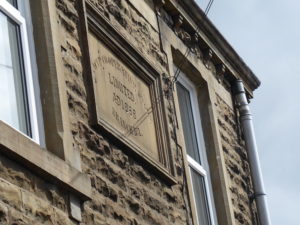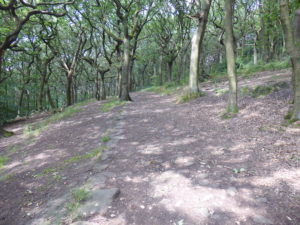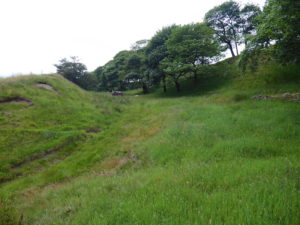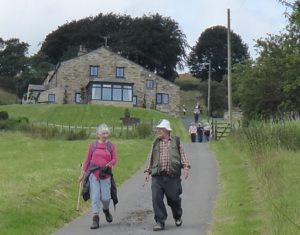On a sunny day, the group set off from Anna’s Café to explore the hillsides and valley of Weir, our main objective being the mysterious Broadclough Dykes. Sites in the area date from prehistory to the industrial revolution and beyond.
Weir contains houses of many dates. It allowed the group to see water-shot coursing and find out about how it can be used to date houses. The group were interested to learn about the Co-operative store and the village’s 1918 war memorial1.

The Co-op store building at Weir. Attribution: C Rousseau Jones
Walking past Weir Hotel, the group climbed to the old turnpike road. The road dates from 1755 and tolls were paid on the road until 18802. There are interesting earthworks on both sides of the road, including the site of quarry.

Track at Broadclough Dykes. Attribution: C. Rousseau Jones
We continued on a rarely used footpath to Broadclough Dykes. The Dykes were described by Dr Whitaker in 18183 as “an entrenchment to which no tradition is annexed that may serve to ascertain either its antiquity, or the end it was designed to answer.” Although the group did not come to a conclusion about the date or use of the earthwork, we did decide that they are spectacular and very interesting.

A dyke at Broadclough, Weir. Attribution: C Rousseau Jones
Leaving Broadclough Dykes, we passed remains of Broadclough Colliery Coal Mine and had a good view of Broadclough Mill. The Grade 2 Broadclough Mill was built in 1824 as successful water powered woollen mill which became steam powered by the 1830s, becoming a cotton spinning mill following enlargement2.

A happy duo on the dyke road. Attribution C. Rousseau Jones
There were more remains to be viewed on Dog Pits Lane. The old bridge is Grade 2 listed and said to date from the 18th century or before. The remains of Dog Pits Mill, a water mill predating Broadclough Mill, could be seen amongst the trees.
Following a path past farms of different periods, the group returned on Weir Lane to Anna’s Café for further refreshments.
PAG would like to thank the landowners who allowed the group access to Broadclough Dykes, which are in area between footpaths and therefore not usually accessible.
- Rousseau-Jones July 2019
- bacuptimes.co.uk
- Wikipedia
- Thomas Dunham Whitaker 1818 An history of the original parish of Whalley, and honor of Clitheroe : in the counties of Lancaster and York